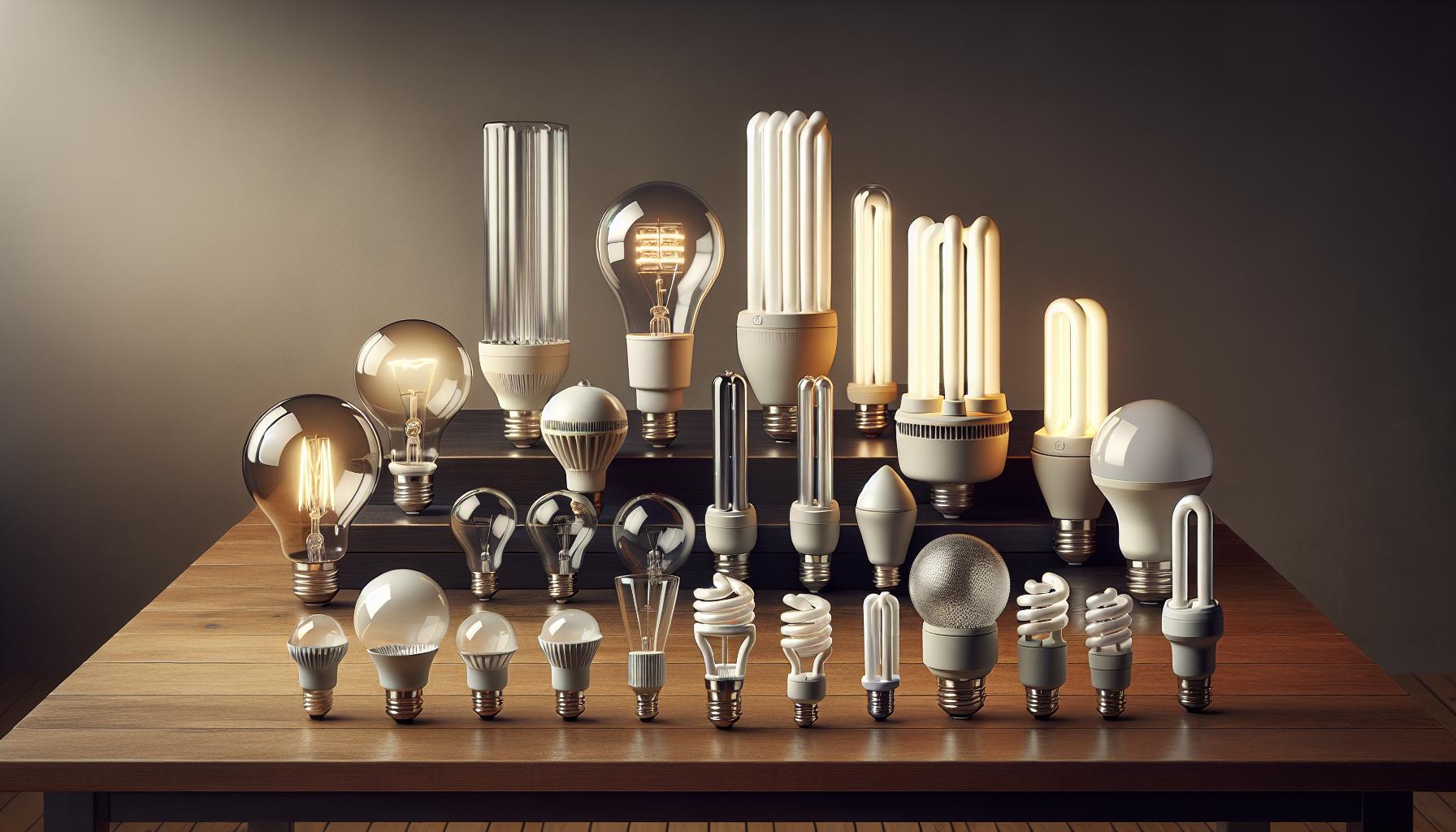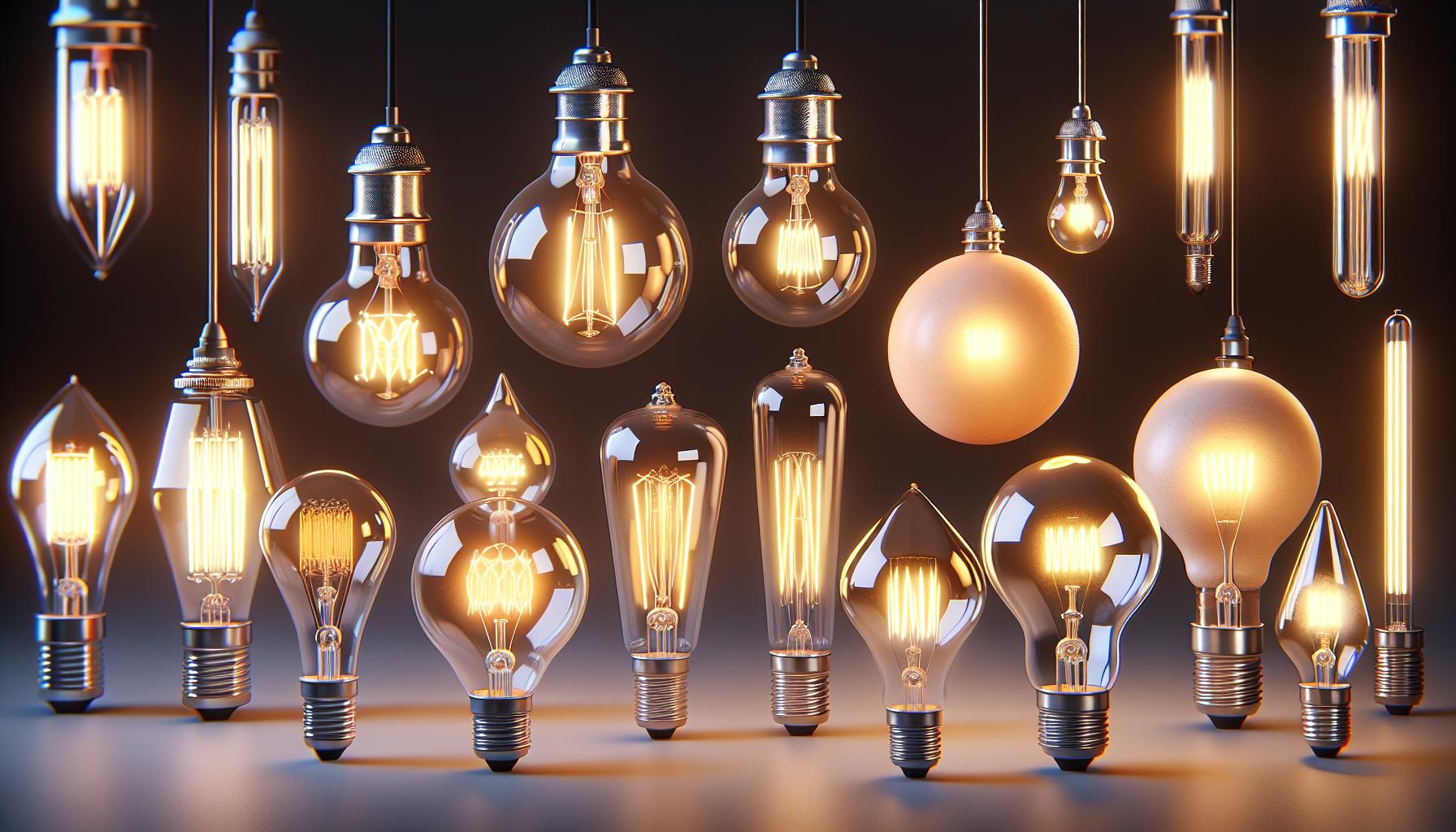Ever found yourself staring at the lighting aisle, overwhelmed by choices? You’re not alone. Picking the right light bulb is like finding the perfect pair of shoes—it’s all about fit and function.
Whether you’re replacing a burnt-out bulb or upgrading your home’s ambiance, knowing what you’ve got is crucial. We’ll help you crack the code on your current bulbs, so you can make an enlightened switch.
Why Knowing Your Light Bulb Type is Important
Imagine trying to find that perfect accessory for your outfit, but you’re not sure what you’re actually looking for. It’s the same with light bulbs. Knowing your light bulb type is as vital as knowing your shoe size when you’re out shopping. It saves time, money, and a heap of frustration. So, let’s shine a light on why discovering your bulb’s identity is key.
First off, compatibility is a big deal. Light fixtures have different requirements – some demand a specific shape or base type. You wouldn’t want to face the annoyance of purchasing a bulb only to find it doesn’t fit, right? Just as you avoid bringing home a pair of heels that don’t match your outfit, ensuring your new bulb works with your existing setup is a must.
Energy efficiency is another factor you can’t afford to overlook. Bulbs like LEDs or CFLs are incredibly energy-efficient compared to traditional incandescent bulbs. Knowing what you have helps you decide if an upgrade could slash your power bills. On that note, here are some energy-saving stats:
| Bulb Type | Energy Savings | Lifespan |
|---|---|---|
| LED | Up to 75% | 25,000+ hours |
| CFL | About 70% | 10,000 hours |
| Halogen | About 30% | 2,000 hours |
Plus, each bulb type emits a certain quality of light. The warmth or coolness of the light, measured in Kelvins, can drastically change the ambiance of a room. Knowing what you have guides you to a choice that’ll keep your home looking its best.
Light quality matters not just for ambiance but also for eye health. The right bulb reduces eye strain and creates a comfortable environment for whatever you’re doing, whether it’s reading, cooking, or crafting your next DIY masterpiece.
Understanding the variety of light bulb types you have might seem like a trivial part of your DIY projects. But like any great project, the devil is in the details. Each piece, each socket, each watt rating plays into the grand design of your home.
Understanding Different Types of Light Bulbs
When you’re knee-deep in a home DIY project, knowing the types of light bulbs available can be a godsend. Incandescent bulbs were your grandparent’s go-tos, but times have changed, and so has technology. First up, LEDs (light-emitting diodes) are the superheroes of the lighting world. They are remarkably energy-efficient, last an eon, and come in a range of colors and dimmer compatibilities.
Then there’s the CFLs (compact fluorescent lamps). These spiraled wonders consume about a third of the energy that old-school incandescent bulbs do and last ten times longer. However, they take a bit to warm up to their full potential, quite literally.
Halogen bulbs, relatives of incandescents, offer a crisp, white light and are better on the energy-saving front than their ancestors but can’t compete with LEDs or CFLs. They’re perfect for spot illumination or tasks that require sharp attention to detail.
Let’s not forget about fluorescent tubes. You’ll often find these long, lean lighting machines in kitchens, garages, or workshops. They cover large areas and don’t slack off on the intensity.
And for those charming vintage vibes, Edison bulbs are where it’s at, with their exposed filaments and warm glow. Be mindful; they’re more about aesthetics than efficiency.
Bulb Bases and Shapes
« What Light Bulbs for Enclosed Fixtures: Expert Tips for the Perfect Fit and Brightness
How to Make Light Bulbs Screw In Easier: Easy Tricks and Tools »
Diving into the nuts and bolts, you’ll notice different bulbs have varied bases – the part that screws or connects into your light fixture. The “E” on an E26 base, for example, stands for Edison, and the number indicates the diameter in millimeters. Always check your fixture’s requirements before buying a new bulb.
Bulb shapes are like the alphabet soup of lighting. A19, G25, PAR30 – these aren’t just random letters and numbers. They tell you the shape and size of the bulb which is key to fitting your preferred style and function.
Incandescent Bulbs
As you delve deeper into the world of light bulbs, it’s impossible not to mention incandescent bulbs — the traditional choice that has lit homes for over a century. With their warm, inviting glow, these bulbs are often associated with the coziness of home life. Despite advancements in lighting technology, incandescent bulbs still have their place in many households.
These bulbs work by passing electricity through a tungsten filament, which heats and produces light. The process is straightforward, but it’s not particularly energy-efficient. In fact, much of the energy used is emitted as heat rather than light. It’s essential to know that incandescent bulbs have shorter lifespans compared to LEDs or CFLs and often need replacing more frequently.
However, if you’re after that timeless ambiance, incandescent bulbs can deliver. They offer a color rendering index (CRI) close to natural sunlight, making them excellent for areas where true color perception is crucial. Let’s look at the practical aspects to consider if incandescent bulbs fit your needs:
- Wattage Ranges: Typically from 40w to 150w.
- Shapes Available: A19, globe, candle, and specialty shapes for chandeliers.
- Dimmability: Most can be dimmed, offering flexibility in mood lighting.
- Regulations: Be aware that various regions have different regulations concerning incandescent bulb use due to their energy consumption.
When choosing an incandescent bulb, it’s also vital to consider the base type. The most common you’ll encounter in North America is the E26 base, often referred to as “medium” or “standard” base. For decorative lights or smaller lamps, you might need an E12, known as the “candelabra” base.
Despite their diminishing presence in the market, there’s still a charming nostalgia attached to incandescent lighting that might make them the right fit for your project. Whether it’s for their color accuracy or simply the aesthetic, knowing when and where to use them can brighten your space in more ways than one.
Compact Fluorescent Bulbs
After considering the charm of incandescent bulbs, let’s throw some light on Compact Fluorescent Bulbs (CFLs). They’re a leap forward in energy efficiency, a perfect blend between the old school incandescence and the futuristic LED. Unlike incandescents, CFLs work by driving electric current through a tube containing argon and a small amount of mercury vapor to generate ultraviolet (UV) light that excites a fluorescent coating on the inside of the tube, which then emits visible light.
CFLs hit the sweet spot for many homeowners due to their affordability and the significant energy savings they offer. So if you’re watching your wallet and your carbon footprint, they’re a go-to. They tend to consume roughly 70-80% less energy than incandescent bulbs, and can last about 10 times longer.
Here’s a quick rundown on what you need to know about CFLs:
- Lifespan: Approximately 7,000-15,000 hours
- Energy usage: About 14-27 watts to produce the same amount of light as a 60-watt incandescent
- Shapes: Spiral, twin-tube, triple-tube, globe, and more
- Color temperature: Ranges from warm yellow to cool blue
| Quality | Incandescent | Compact Fluorescent |
|---|---|---|
| Lifespan (hours) | 1,000-2,000 | 7,000-15,000 |
| Energy Used (for 60W output) | 60 watts | 14-27 watts |
One thing to note about CFLs is that they contain trace amounts of mercury, a necessary evil for the time being. No panic though—technology is always advancing and becoming safer. Just ensure you’re handling them with care and recycling properly.
When you scout for CFLs, remember to check compatibility with your light fixtures and dimmer switches. Some CFLs are specially designed to dim, while others are not—a vital detail for achieving your desired ambiance. Plus, they can take a moment to warm up to full brightness, something to keep in mind if you’re looking for instant illumination.
LED Bulbs
As you delve into the vibrant world of home lighting, it’s impossible not to highlight LED bulbs. These wonders represent the pinnacle of efficiency and versatility, lighting the way for your DIY projects with an unmatched sparkle.
LEDs, or Light Emitting Diodes, take the cake when it comes to energy-saving options. They consume a fraction of the power that incandescent bulbs or CFLs do. You’ll see the difference on your electricity bill, with LEDs using up to 85% less energy than traditional bulbs. Plus, you’re not just saving costs; you’re also taking a step toward sustainability.
But what truly sets LEDs apart is their longevity. These bulbs last an extraordinary amount of time. Imagine installing a light and not worrying about changing it for over a decade—LEDs make this possible. They can last up to 25,000 hours or more, making them a steadfast companion for your home’s alcoves, art corners, and workbenches.
Notably, LEDs offer a range of color temperatures, from warm yellowish hues, perfect for cozy environments, to bright, daylight-like whites ideal for concentration and detailed tasks. Here’s a crisp detail you’ll love: LEDs don’t waste time warming up. When you flick that switch, they’re instantly at full brightness.
| Type | Energy Use | Lifespan (Hours) |
|---|---|---|
| LED | Up to 85% Less | Up to 25,000+ |
| Incandescent | – | 750-2,000 |
| CFL | 25-35% Less | 8,000-15,000 |
Yet there’s more to LEDs than meets the eye. They’re incredibly durable, with no fragile filaments to worry about. You can also find them in a multitude of shapes and sizes, fitting snuggly into your most intricate light fixtures. Whether it’s strip lighting for under cabinets or globes for pendants, LEDs are as adaptable as you need.
When embarking on your lighting ventures, consider LED bulbs for smart and contemporary illumination. Always remember to check if they’re compatible with dimmer switches and fixtures in your abode.
Conclusion
You’ve got the scoop on the best bulb for your DIY projects—LEDs are the way to go. They’re not just energy-efficient but also long-lasting and versatile enough to suit all your lighting needs. Whether you’re looking to create ambiance or need bright light for work, you can find an LED bulb that fits the bill. Remember to double-check that they play nice with your dimmers and fixtures and you’ll be set. Here’s to a brighter, smarter home!
Frequently Asked Questions
What types of light bulbs are best for DIY projects?
LED bulbs are highly recommended for DIY projects due to their efficiency, versatility, longevity, and the variety of shapes and sizes available.
How long can LED bulbs last compared to other light bulbs?
LED bulbs can last up to 25,000 hours or more, which is significantly longer than incandescent bulbs or CFLs.
What are the advantages of using LED bulbs?
LED bulbs are energy-efficient, durable, and reach full brightness instantly. They also offer various color temperatures and sizes, making them ideal for multiple lighting applications.
Can LED bulbs be used with dimmer switches?
When choosing LED bulbs for dimming purposes, ensure they are compatible with dimmer switches, as not all LED bulbs are dimmable.
Is the light output of LED bulbs instant?
Yes, LED bulbs reach full brightness immediately when turned on, unlike some other types of light bulbs that require warming up.





